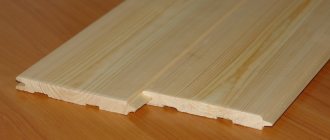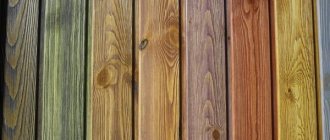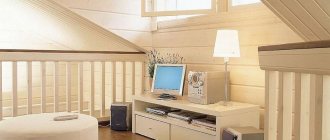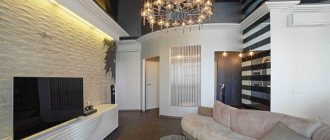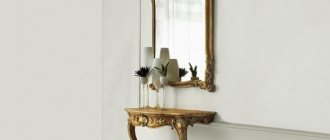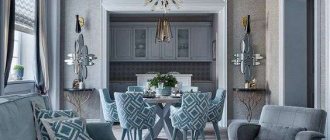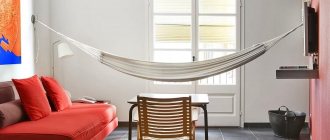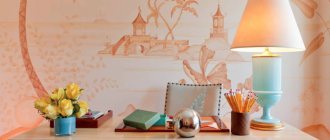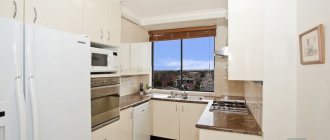Varieties and tips for choosing
Lining is thin cladding boards obtained by processing wood. It is used to decorate the interior and exterior of the house.
Its types vary depending on the type of wood, appearance and method of fastening:
- For the manufacture of wooden lining, deciduous and coniferous wood is used - ash, oak, beech, aspen, pine.
- Plastic is made from PVC using extrusion, that is, extrusion at a certain temperature.
- MDF-based plastic is assembled using glue from wood shavings, so it is characterized by high density.
Options for covering walls with clapboard Source m-club.spb.ru
Based on the appearance and shape, clapboard can be divided into three types:
- eurolining - produced in the form of narrow long boards;
- blockhouse - imitation of round logs, the outer side has the shape of a semicircle;
- “American” - has the appearance of a wooden beam in the shape of a rectangular trapezoid.
An example of eurolining Source derevo-prom.ru
The widespread use of lining in the interior can be explained by many reasons. First of all, it allows you to create a beautiful, cozy interior. For its production, natural, eco-friendly materials are used, which can be used without restrictions in cramped urban homes. There are no harmful inclusions in it.
This is a living textured material, it helps retain heat in the room, serves for sound insulation, and allows air to pass through.
Besides:
- lining is affordable;
- lends itself well to any type of processing: it is painted in different colors, creating bright accents for interior decoration;
- it is easy to install; there is no need to hire a team of craftsmen;
- never goes out of fashion, wood is always in demand and appropriate, especially for country, Provence, Swiss chalet, and Scandinavian styles.
A room covered with eurolining Source www.allservice.ru
Lining in the interior harmonizes and looks beautiful with any of the modern materials - stone, ceramic tiles, high-quality textiles, glass, leather. There is no need to additionally prepare the walls or level them.
However, there are minor disadvantages of lining, for example:
- It is installed on a pre-prepared crate. Due to this, a loss of height and width of the room is possible.
- Easily absorbs moisture. Treat the surface with special compounds to prevent this.
- It is fire hazardous, so treatment with fire retardants is mandatory.
- Certain types of wood, for example, oak, hornbeam, cedar, are very difficult to paint in light shades, although aspen or pine can be colored without effort.
- It is difficult to dismantle and prepare the wall surface for a new type of finishing if in the future you need to dismantle or replace the lining. This will require more effort and time than replacing wallpaper or whitewashing.
The surface of the walls and ceiling is finished with lining; it can be easily painted in different colors and tones, which allows it to be installed in any interior, even a very strict one, without restrictions.
Wall cladding Source vdknn.ru
If the ceiling of the room is too high, it can be visually lowered by using clapboard paneling. This looks especially organic for a loft interior.
Interior of a house in a hunting style Source www.best-mobile-app.club
One wall, trimmed with clapboard, is a bright accent inside the room and serves as thermal insulation.
Lining in a modern interior Source legko.com
If you artificially age the lining and assemble a wall panel, it will organically fit into the “loft” or “country” styles.
Atmospheric living room Source www.instructables.com
Solutions used for coloring
There are many means for covering lining. These are compositions for internal and external cladding of premises. They differ in composition, speed and quality characteristics. For example, a wooden exterior façade is affected by ultraviolet rays, moisture, high and low temperatures, so the finishing coating should contain the predominant majority of protective components.
You can decorate the lining of the interior of the house with ordinary enamels and paints. Painted natural boards have an original appearance. Each mixture after painting gives a certain effect to standard lining. The choice of solution depends on the preferences of the owner of a country or city building.
Protective agents: properties and application technology
Proper and timely use of protective equipment allows natural lining not to lose its appearance and original structure for many years. Antiseptic agents can increase the moisture resistance and durability of the material. The solutions also prevent damage by insects, various microorganisms, and the formation of mold, which is detrimental not only to the lining, but also to the health of the dacha owners. Based on the basis of manufacture, antiseptics are divided into four main groups:
- Organic solvents. They penetrate deep into the material, destroy areas of rot and mold, and prevent the appearance of new ones. Actively combat biological pollution. They have a pungent odor. Can be used indoors and outdoors;
- Water-soluble products. Temporarily protect wood in contact with moisture. Used for preventive purposes;
- Oil antiseptics. It is recommended to treat lining that is in the open air in contact with the ground with moisture. Effectively protect material in difficult conditions;
- Combined mixtures. The solutions contain various substances. Inherent in each group. They cope well with mold, moisture, and high temperatures. Can be used for both internal and external processing.
To reduce the negative impact on the lining, various solutions are used. Bioprotective compounds successfully fight pests, mold, and mildew. Fire retardants provide fire protection and slow down the spread of fire. Complex protective agents – biopyrenes – are used as a base coating. To bleach wood, you can use chlorine-containing mixtures, hydrogen peroxide, and special industrial liquids. Lining made from low grades of wood must be treated with primer to fill the pores.
The lining is covered with protective agents before varnishing and decorative treatment. The application technology consists of impregnating each fragment separately and on both sides. Using a brush or roller, spread the antiseptic over the entire surface in a thin layer. It is necessary to reach all hidden areas (corners, recesses). Wooden boards should dry without touching each other.
Varnish compositions and their properties
To refresh the antiseptic-impregnated lining and refine the finish, the wood is varnished. The required composition of the solution is selected based on the type and purpose of the room.
Oil-based resin varnishes can have different shades - from transparent to dark chocolate. The coating hardens quickly, forming a dense film. The moisture-resistant surface is easy to clean and is completely ready for further painting. The main disadvantage is the high level of fire hazard.
Alkyd universal solutions have a high level of resistance to external negative factors. They are absorbed deep into the wood, so they take a long time to dry (up to 3 days). Alkyd-urea varnishes have almost identical characteristics. Before use, the solution must be mixed with an acid hardener. It has a strong shine after hardening. Disadvantage: high price, rapid ignition.
Alcohol polishes and varnishes are used in minimal quantities to coat individual elements of the lining. Apply a very thin layer of solution using a cotton swab or small brush. The dried coating noticeably shines and gains elasticity. Some types of alcohol mixtures do not tolerate sunlight, so they cannot be used on large areas of the lining.
The composition of nitrocellulose varnishes includes plasticizers, resins, and pigment. After application to wood, they form a dense protective and decorative coating. They do not cover lining intended for finishing facades. Nitrovarnish does not tolerate sunlight. High temperature.
Water-based polyurethane and acrylic solutions are applied to the lining in several layers due to the high volatility of the mixture. They have surface tension properties and do not crack or wear off. The varnish adheres tightly to the wood, protects it from chemicals and getting wet.
Paints in different compositions for coating wooden lining
A wide variety of decorative mixtures allows you to choose the most extraordinary solutions to implement bold design ideas. With the help of paint and varnish products, you can give the lining absolutely any color and texture. The following paints can be used for interior decoration of a country house:
- Acrylate. Resistant to precipitation, retains shine and color for a long time. The paint has good adhesion and wears out slowly;
- Oily. It is well absorbed into the lining, does not allow moisture to pass through, and allows the material to breathe. May fade over time;
- Water-based. Preserves the wood texture and gives a matte finish. The paint dries quickly and has no odor;
- Silicone. Withstands impressive mechanical loads. It has good vapor permeability and masks defects. Retains color for 30 years;
- Alkyd-based enamel. Suitable for decorating lining. During prolonged drying, it emits a pungent, unpleasant odor. Fades quickly in the sun;
- Wax. Traditional, natural material for processing lining. After painting, it retains the natural pattern of wood, gives a matte, glossy shine;
- Silicate. The composition includes liquid glass, which significantly improves the characteristics of the paint. She is not afraid of ultraviolet rays. A dye with increased fire resistance protects the lining from temperature changes.
Painting the lining inside the house in different colors: beautiful ideas in the interior
By varying different colors, you can significantly expand the choice of style, create bright accents indoors and at the same time make the wood more resistant to adverse influences.
Lining for the ceiling Source domostroy-khv.ru
The lining in the interior does not always suit the style of a particular room; painting it in different colors makes it more suitable for the interior. The material must be painted before it is installed on the wall or ceiling.
Using clear varnish makes the wood texture more pronounced. You can slightly zone the surface.
Lining on the balcony Source domodedovo.mebelsam.net
The clapboard ceiling in a country or Provence style room should be painted white and the beams made dark.
Beams on the ceiling in the kitchen Source steaten.com
White color is universal for any design. It fits easily into the room; the combination of light matte and varnished lining on the walls and ceilings is especially beautiful. This gives a feeling of open space and spaciousness. White matte board is a necessary element of the Scandinavian style.
Kitchen interior Source legko.com
The warm varnished surface emphasizes the warmth and comfort of the Provence style.
Interior of a house with clapboard Source Interior of a house with clapboard
The use of oil paints creates an unusual texture on the surface of the wood. Some designers generally advise applying paint with your hands rather than with a brush.
Matte varnish for lining Source optolov.ru
It is very stylish and fashionable to cover the walls not completely, but in separate places, while the boards can be laid out in a herringbone pattern, diagonally or at an angle.
Partial cladding Source botanhelp.ru
The surface treated with a blowtorch and then painted with oil paint looks unusual. This is a Japanese method that has gained great popularity. Characteristic for rustic or natural styles.
For those who like bright and unexpected solutions, the option of decorating walls with lining in pastel shades is suitable. In this case, the ceiling is painted in a bright color, for example, purple or Tiffany.
Dark lining looks good with phytowall slabs. This is relevant for eco-style, especially if the design contains stone or other natural material.
Eco-style apartment Source interiorcom.ru
If part of the room is decorated with soft pink or soft blue lining, then in combination with bright furniture facades, this will give the room a special coziness and warmth. A baguette is installed along the edges of the lining to differentiate the finishing materials.
Ceiling paneling Source ms.decorexpro.com
If the house has an attic, then its sloping walls are covered with wallpaper, and the ceiling is lined with clapboard in discreet colors, so as not to additionally load the room.
For the Provence style, the lining is aged. This gives the interior a lived-in and warm feel.
If the interior is decorated in the Art Nouveau style, the lining should be painted gray or silver and varnished on top to create a characteristic gloss.
Gray Hall Source onidea.net
For the loft style, a rough, untreated American surface is best suited.
Painting lining inside the house Source legko.com
Golden yellow colors represent natural warmth and energy. However, an excess of this color gives a sauna effect. Golden shades should be combined with blue, red, green, and pastel tones.
Interior with exposed beams Source www.oakmasters.co.uk
Brown shades are appropriate in spacious, brightly lit rooms. In an apartment, if you want to use dark colors, you can resort to contrasting color combinations or creating an accent.
Wall made of lining in the interior Source www.rock-cafe.info
If the walls of the children's room are decorated with clapboard, it is recommended to paint them light blue or white. The result is a room for a child with Mediterranean or Provencal style motifs.
Decorating a house with imitation timber inside Source www.allservice.ru
The “country” style requires painting the nursery in a soft yellow color.
Decorating a children's room Source blog.sina.com.cn
A Scandinavian-style bathroom requires aged boards painted white.
White lining in a Scandinavian style bathroom Source legko.com
How is the lining installed?
The process of installing the lining is very simple. To do interior cladding with your own hands, you need to have basic skills, as well as a simple set of tools: a screwdriver, a building level, wood screws, sealant. On average, installation work takes several days.
Installation of lining inside the house takes place in several stages:
- installation of wooden sheathing using small planks and bars;
- if necessary, create a layer of thermal insulation (for this you can use polystyrene foam or mineral wool boards);
- installation of the starting strip of the lining (if the panels are horizontal, their installation must begin from the bottom);
- careful adjustment of all planks (using the tongue-and-groove system) and securing the structure using self-tapping screws;
- final treatment of the finished surface with paint and varnish solutions.
The installation process looks very simple, and you can do it yourself without any problems.
Lining in the kitchen interior
Wood on the walls and ceiling of the kitchen looks very beautiful and organic. The lining can be used to completely finish all walls or just for the wall and floor of the dining area. A good option is a wooden kitchen apron, but it must first be treated with antiseptic agents and moisture-resistant paints.
Sometimes clapboards in the interior outline the entire work area around the kitchen unit. In this case, some of the furniture and accessories must be decorated in the same color scheme as the surface of the walls. The facade of the furniture should be made of smooth material. It is better to replace the upper cabinets with open shelves so as not to clutter the room and make it more laconic.
If the kitchen interior is decorated in a country style, then a natural color will look great. It’s beautiful if only the lower part of the walls is finished with wood. The rest can be painted with regular paint or wallpaper.
If the kitchen is small and the ceiling is high, it is recommended to place the boards horizontally. This visually increases the area of the room. Low ceilings are visually raised by vertical installation of lining.
Wooden paneling in the kitchen Source m.post.naver.com
White, gray, and beige colors are suitable for the Scandinavian style. For eco-style, wicker baskets, vases, natural textiles, and wooden panels are selected.
For “Provence” all pastel shades are appropriate. Pistachio or vanilla colored walls are very beautiful. One wall is trimmed with clapboard of this shade, which plays a purely decorative role. Shelves are hung on it with jars for spices and various small items. Furniture and cabinets are selected in the same shade.
The “eclectic” style requires finishing one or two walls completely with clapboard, placing it horizontally.
Plastic lining is ideal for the kitchen. It is easy to wash and care for. If the room is completely lined with clapboard, you need to choose furniture in bright colors and eye-catching curtains. If the color is the same everywhere, then you need to highlight the dining area, for example, choose a table and chairs in bright colors.
Wall panels in the kitchen Source adekoma.ru
Installation of lining
Let's look at a simple example of how to properly lay lining on the ceiling. To work, you only need to stock up on the simplest construction tools and the desire to create.
- The first stage is laying the sheathing. Pre-prepared wooden blocks measuring 20x30 cm are placed on the ceiling parallel to each other in increments of 0.7-1 m. Since the surface in question does not experience strong mechanical stress, the increment can be increased. After installation, the lathing must be checked with a horizontal level.
- The second stage is laying the lining. There are two ways to fasten the material to the ceiling: using special clips or driving individual elements into grooves with nails. For work, nails 4.5-6 cm long are used. They should be driven into the groove at a slight angle to the built-in sheathing.
After installing the first panel, the second element is taken and inserted with a tenon into the groove of the already installed element. Then it is tapped all the way and nailed. Proceed in the same way with the remaining structural elements. With a little practice, you can complete the work very quickly without compromising the quality of the result.
As you can see, lining is an ideal option for covering a ceiling in a modern style. Properly done work will allow you to achieve high-quality and effective results. Happy renovation!
Lining in the interior of the hallway
The hallway is decorated with wood to create “Russian hut”, “French Provence” or “country” styles.
Use lining classes:
- A or B (medium quality);
- “extra” (high-quality expensive material).
Depending on the desired effect, it is laid in a vertical or horizontal direction.
Wood is practical, so you don’t have to worry about preserving the beauty of the walls, even if there are small children or active animals. But even if a particular part of the wooden surface is damaged, it is easy to replace or repair. In addition, the lining will last a long time.
Clearly defined clapboard panels look beautiful in the hallway. They go well with textured plaster, wallpaper or paint.
Corridor design with clapboard Source www.pinterest.com
You can choose natural wood colors, such as oak, but you will need to think carefully about the lighting. Use several shades of the same color, for example, blue, on the ceiling and walls. In combination with the color of the wood, this creates an unusually pleasant environment.
If there is not enough natural light, you can cover the walls with white clapboard. However, its monotony must be diluted with accessories and furniture in bright colors, otherwise the room will become boring and cold. Any color goes well with white.
Chocolate shades look beautiful as an accent on one of the walls or in the corner of the hallway. This accent can be supported with the same accessories.
Decorating the walls of the hallway Source www.pinterest.com
Types of lining
This is the name of a board that is used for finishing indoors or outside a building. There is a groove on one side, and a tenon going into it on the other. Due to this, the sheathing firmly closes into a single plane without gaps, does not bend or deform over time. Shallow cuts are often made on the back side, which serve for ventilation.
Different types of lining differ in profile cross-section. Standard - smooth, with a pronounced seam between the individual boards. The calm type has smoothed corners. The blockhouse has a curved, rounded surface and is used to imitate a log. The American one has different thicknesses at the edges; when assembled, it resembles a wall made of overlapping boards or timber with a trapezoidal cross-section. Eurolining is long and narrow, has parallel cuts on the outside. There is also a double-sided option, in which both planes are front and look the same.
Lining is made from different types of wood. Pine is a budget option, has a pronounced pattern, and is often tinted or painted. Larch is resistant to moisture, making it suitable for damp rooms. Linden releases beneficial substances and has a pleasant pinkish tint. Spruce, ash, oak, aspen, beech, etc. are also used.
The boards differ in the number of knots, small cracks, unevenness and other defects. Depending on this they are divided into classes. Extra (premium) has no disadvantages, but is the most expensive. It is followed by A, B, and the most budget - C.
The sizes of all types are within the following limits:
- from 2 to 3 meters in length;
- 8-12 cm wide;
- 1.2-2.5 cm thick.
A ceiling made of wooden lining, regardless of the specific type, has similar pros and cons. The advantages of the material include:
- environmental friendliness (based on natural wood);
- beautiful appearance;
- variety of design due to the use of different breeds, tinting and coloring;
- relative accessibility of installation (no specialized skills or tools required);
- the ability to hide communications or defects in the rough ceiling under the finished ceiling;
- heat and sound insulation;
- ability to be combined with other materials;
- relatively low price.
The disadvantages include:
- reduction in level due to the peculiarities of installing a suspended ceiling (lining is mounted on top of a wooden frame);
- instability to moisture and fungus;
- flammability;
- the difficulty of changing the finish in the future if you are tired of this look.
Important! For safety, the boards are coated with fire-retardant and anti-mold impregnations. To protect against moisture, apply a layer of varnish or paint.
How to paint lining like bleached oak
Light shades are gradually replacing dark, cozy interiors that were fashionable until recently. One of the modern trends is the use of the “bleached oak” technique, which is a special wood coloring technology.
Light lining on the wall Source www.homeawakening.com
The purpose of this painting is to create a contrast between the shade of natural wood and the whitened surface. The more pronounced the contrast, the more valuable the result obtained.
As a result of this treatment, the wood texture is clearly visible under a thin layer of varnish, and the surface itself acquires an exquisite matte finish.
Ceiling decoration with bleached clapboard Source www.pinterest.com
Possible wood color options when using this technology:
- dark or light;
- aged surface;
- yellowish or pinkish surface;
- a grayish tint with light lilac notes (this is the most valuable option).
Unusual painting Source lesobirzha.ru
The “bleached oak” effect can be achieved in several ways:
- Use ready-made tinting (stain) “Bleached Oak” or “Rime”. It is applied twice in a very thin layer.
- Oil with wax. The color is chosen at your discretion. Can be applied in two thin layers. Can be applied once in a thick layer and rubbed in with a cloth to achieve a crisp texture.
- Pigment primer with polyurethane (name “white” or “bleached”). It is diluted in a large volume of diluent (80% of the total volume). Over time, this surface turns yellow.
- Pigment primer (acrylic). Also diluted by 80% with thinner. Retains whiteness for a long time.
Decorating a room in country style Source dizainvfoto.ru
A thin layer of paint is applied to the dry surface of the wood. The stain is usually deeply absorbed and does not apply completely evenly. Aniline paint is better suited: it applies beautifully, without streaks and dries well. The powder for making the dye must be dissolved in water or denatured alcohol.
You can use drooping dyes in acetone, but you need to be careful with them. Apply the paint in two layers, this ensures a lasting matte surface. The final stage is shellac treatment to obtain a light tint. Due to this, excess whitewash is removed.
The wax is applied evenly, then wiped with a cloth or steel wool. Then the surface is left to dry and the treatment is repeated again. Remaining wax is immediately removed.
The result of this procedure is an ultra-modern interior design in a rustic or Scandinavian style and a well-protected wood surface.
Kitchen wall decoration Source 1povagonke.ru
Choosing lining for kitchen decoration
For kitchen cladding, you can use traditional lining, which is characterized by ease of installation. This type of stilt is produced without a chamfer near the tenon, so the material is used to imitate a surface made of timber.
Landhouse is a wooden lining, which is processed using different methods during the production process, so there is a complex pattern on its surface. The block house has a rounded surface, so the building material looks like logs. Double-sided lining does not have a back side, so it is used to install partitions in the kitchen, separating the work area and the living room.
Painting lining at the dacha: types of coatings, interesting ideas, technologies
Materials for a country house must be environmentally friendly, durable and safe for humans. In addition, the house does not have heating in winter, so increased moisture resistance is required, since condensation can form on the walls. Lining for a country house can be a completely acceptable option if it is first subjected to special treatment and installed correctly.
Various paints, varnishes and impregnations are used to:
- improve the decorative properties of the lining;
- prevent darkening;
- protect from mold, mildew, rot;
- reduce the amount of resin released;
- improve water-repellent properties to prevent swelling;
- increase the ability to withstand high temperatures.
Painting clapboard walls Source www.roamarch.com
Each type of treatment is designed to solve one or more of these problems, so it is usually necessary to carry out complex treatment using several means:
- Primer. The main purpose of application is to create the basis for a future decorative coating. At the same time, it increases the adhesion of the material, fills voids, levels the surface, prevents the appearance of resin and the penetration of water.
- Oil-wax. Forms a hard water-repellent film on the surface. Important for high humidity. You don’t have to cover it with anything; you can lightly paint it.
- Drying oil. The product is almost no longer used; it is being replaced by more modern, effective products. Increases hydrophobicity. Disadvantages - the surface loses its original color and becomes sticky. It is possible not to paint, but then you will have to repeat the treatment often.
- Fire retardants. Increases fire resistance.
- Antiseptics. Effective against pests, fungi, mold. May be used to clean already contaminated areas. Apply as a base for final painting.
- Bleaches. Eliminate stains and darkening in certain areas.
- Linseed oil. Increases moisture resistance, reveals the structure of the tree. There is no need to further process it, as the natural pattern is preserved. It is advisable to color it.
When choosing products for coloring lining, you need to remember that some of them are designed to emphasize the natural structure of the wood; all patterns and annual rings become pronounced and acquire a unique tone.
Varnish coating of lining Source legko.com
Other paints, on the contrary, cover the surface with a massive layer and hide the texture of the wood. Opaque paints include acrylic, oil, and water-based paints.
Transparent are varnishes, stains, and some other paints. They are used when the lining is new, just installed, to preserve its beauty and texture.
Modern beautiful interior Source www.ivd.ru
Old wooden panels need to be treated with opaque compounds. To make such a surface look beautiful, first remove the top layer of old wood and sand it. This is a rather time-consuming and labor-intensive method. It is advisable to paint cheap spruce and pine with thick paint, as they do not look beautiful enough.
Colors are selected based on the design of the house or a separate room. Using different coatings you can zone a room, place accents, and make the design more attractive:
- Lucky. It is advisable to choose acrylic, alkyd, water-based. They practically do not affect the texture and beauty of the wood. Provides additional protection.
- Decorative glaze (stain). You can paint the wood in any shade and give it a distinct structure. Has protective properties.
- Water-based paints. Suitable for dry rooms, provide a matte or semi-matte surface.
- Oil paints. A strong opaque film of the desired color is formed.
- Acrylic paint. Creates a matte or shiny film.
Interior in white Source dizainvfoto.ru
Decorating an attic with clapboard Source poradovat.ru
The color of the clapboard should match the interior. If the decoration of the house is new, then it is better to use transparent varnishes and azures. The old surface is painted.
The lining is also used for exterior decoration of the walls of a country house; it is used to line the roof of the terrace and roof overhangs. Different types of opaque paints prevent wood from darkening in the light and create a kind of ultraviolet filter.
Many impregnations contain fire retardants and antiseptics. Or they need to be applied before the main painting. This is done with a brush; you can immerse the boards in the prepared composition. Wood that has darkened over time can be bleached.
Decorating the inside of a country house Source www.pinterest.com
Features of ceilings
A lining ceiling is a popular and unusual way of finishing rooms, which, moreover, has a number of undeniable advantages:
- Decorative. The appearance of the products is unique, and they are suitable for any interior style.
- Easy to install. Suspended structures are very easy to install, and they do not require additional processing.
- Masking of defects. Decorative wooden panels perfectly hide any surface irregularities and also allow you to hide all communication wires.
- Excellent thermal conductivity. Wood is known for its ability to retain heat, so lining ceilings perfectly retain heat indoors.
- Environmental friendliness. Structures made of wood are absolutely safe for the human body and can even maintain the desired microclimate in the house.
- Compatibility with most finishing materials. The lining ceiling goes well with plastic, metal, and any other material. It all depends on the chosen model of finishing panels.
